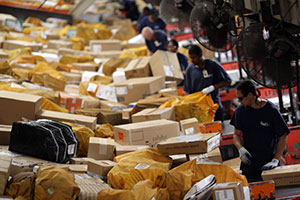FedEx Focuses on Boxes, Marks Cyber Monday Peak

'Tis the season for packages.
No one knows that better than the experts at FedEx Corp.'s national packaging lab, which is all about thinking inside the box.
At the lab in suburban Collierville outside Memphis, Tennessee, technicians use machines to drop, squeeze, smash and vibrate packages containing items like flat-screen TVs, Memphis barbecue, cakes and guitars.
FedEx ranks No. 2 on the Transport Topics Top 100 list of the largest U.S and Canadian for-hire carriers.
Before a product is shipped from factory to warehouse or store, the lab works with manufacturers to vet and sometimes help redesign the packaging, typically made of corrugated cardboard.
"Just putting something in a box and shipping it sounds simple, but it isn't always," said project packaging engineer David Nelson, a 31-year industry veteran with a degree in packaging science from the Rochester (New York) Institute of Technology.
FedEx was expected to move millions of packages on Cyber Monday, the mother of all package pickup days, as a weekend of online shopping disgorged a flood of packages into its shipping network.
Stoked by a surge of online shopping over the long Thanksgiving weekend, the holiday shipping season officially kicked off for FedEx, UPS and other companies that carry the bulk of e-commerce.
Cyber Monday marked the first of four Mondays between Thanksgiving and Christmas that FedEx expected to be among its busiest days ever.
FedEx officials believe the company will move at least 357.5 million packages during the season, about 10% more than the 2015 holidays, when it handled 325 million.
Industry consultant Satish Jindel has projected FedEx's peak season volume will hit 370 million, boosted by such big events as Cyber Monday.
While FedEx hasn't singled out its anticipated busiest day this year, Jindel believes Cyber Monday will be the biggest day for pickups and Dec. 19, the Monday before Christmas, will bear the most deliveries.
Holiday season volume has mushroomed in recent years because of growing e-commerce, largely moved by the truck-based FedEx Ground network. Online shopping is expected to exceed 10% for the first time this holiday season.
For Nelson's crew, peak season provides an opportunity to reflect on year-round efforts to help internet retailers and other customers to build better boxes.
The lab, which relocated from Memphis to Collierville in 2013, simulates potentially destructive forces found in planes, trucks, warehouses, even FedEx sorting conveyors. The engineers also help customers choose packaging that doesn't take up too much real estate in planes and trucks.
With higher charges for large boxes and oversize items, FedEx has pushed shippers to eliminate empty space inside boxes and to pay a premium for moving items that can't be handled by highly automated sorting facilities such as the FedEx Express world hub at Memphis International Airport.
In a new wrinkle this holiday season, FedEx opened six temporary regional annexes just to handle large items increasingly shipped by online merchants: big TVs, bicycles, mattresses, trampolines and so forth.
Some warehouse operators require companies to get packaging pre-approved by FedEx before products can be shipped from a warehouse. Such concerns are causing manufacturers to put more emphasis on boxes, with some product makers having boxes tested by FedEx before they'll offer a product for sale online, Nelson said.
As Nelson led a tour of the lab, technician Donnie Dixon worked his way through a stack of boxes sent to the lab for testing. Dixon used equipment to drop each box 10 times from different angles, apply hundreds of pounds of pressure to the exterior and shake each box, alternating between motions mimicking an aircraft cargo hold and a truck bed.
Halfway through the drop test, one box started coming apart at the seams. "That one didn't work out too well," Dixon said.
That's the kind of package Nelson doesn't want landing on a consumer's doorstop this holiday season, giving a black eye to the shipper or FedEx.
"It could have been bad packaging, but in the customer's eyes, they don't necessarily know that. They just know that FedEx delivered it and it arrived damaged, so we must have caused the damage," Nelson said.
"We're trying to prevent any of those negative aspects, to make sure that the customer's product gets there in the condition, on time, and every one is happy with that transaction."
Distributed by Tribune Content Agency, LLC




